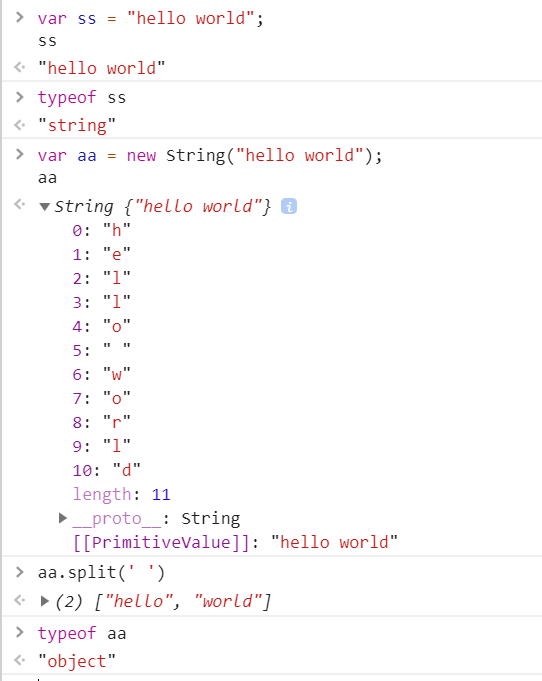在JavaScript里,构造函数通常是认为用来实现实例的,JavaScript没有类的概念,但是有特殊的构造函数。通过new关键字来调用定义的构造函数,你可以告诉JavaScript你要创建一个新对象并且新对象的成员声明都是构造函数里定义的。
在构造函数内部,this关键字引用的是新创建的对象。基本用法如下:
function Car(model, year, miles) {
this.model = model;
this.year = year;
this.miles = miles;
this.output= function () {
return this.model + "走了" + this.miles + "公里";
};
}
var tom= new Car("大叔", 2009, 20000);
var dudu= new Car("Dudu", 2010, 5000);
console.log(tom.output());
console.log(dudu.output());
上面的例子是个非常简单的构造函数模式,但是有点小问题。首先是使用继承很麻烦了,
其次output()在每次创建对象的时候都重新定义了,最好的方法是让所有Car类型的实例都共享这个output()方法,这样如果有大批量的实例的话,就会节约很多内存。解决这个问题,我们可以使用如下方式:
function Car(model, year, miles) {
this.model = model;
this.year = year;
this.miles = miles;
this.output= formatCar;
}
function formatCar() {
return this.model + "走了" + this.miles + "公里";
}
这个方式虽然可用,但是我们有如下更好的方式。
1、构造函数与原型
JavaScript里函数有个原型属性叫prototype,当调用构造函数创建对象的时候,所有该构造函数原型的属性在新创建对象上都可用。按照这样,多个Car对象实例可以共享同一个原型,我们再扩展一下上例的代码:
function Car(model, year, miles) {
this.model = model;
this.year = year;
this.miles = miles;
}
/*
注意:这里我们使用了Object.prototype.方法名,而不是Object.prototype
主要是用来避免重写定义原型prototype对象
*/
Car.prototype.output= function () {
return this.model + "走了" + this.miles + "公里";
};
var tom = new Car("大叔", 2009, 20000);
var dudu = new Car("Dudu", 2010, 5000);
console.log(tom.output());
console.log(dudu.output());
这里,output()单实例可以在所有Car对象实例里共享使用。
另外:我们推荐构造函数以大写字母开头,以便区分普通的函数。
2、只能用new吗?
上面的例子对函数car都是用new来创建对象的,只有这一种方式么?其实还有别的方式,我们列举两种:
function Car(model, year, miles) {
this.model = model;
this.year = year;
this.miles = miles;
// 自定义一个output输出内容
this.output = function () {
return this.model + "走了" + this.miles + "公里";
}
}
//方法1:作为函数调用
Car("大叔", 2009, 20000); //添加到window对象上
console.log(window.output());
//方法2:在另外一个对象的作用域内调用
var o = new Object();
Car.call(o, "Dudu", 2010, 5000);
console.log(o.output());
一种就是作为函数直接调用,那么this就全指向window去了;
二种就是使用call方法绑定this对象
该代码的方法1有点特殊,如果不是用new,而是直接调用函数的话,this指向的是全局对象window,我们来验证一下:
//作为函数调用
var tom = Car("大叔", 2009, 20000);
console.log(typeof tom); // "undefined"
console.log(window.output()); // "大叔走了20000公里"
这时候对象tom是undefined,为什么呢?因为函数Car()没有返回值,而window.output()会正确输出结果,而如果使用new关键字则没有这个问题,验证如下:
//使用new 关键字
var tom = new Car("大叔", 2009, 20000);
console.log(typeof tom); // "object"
console.log(tom.output()); // "大叔走了20000公里"
3、强制使用new
上述的例子展示了不使用new的问题,那么我们有没有办法让构造函数强制使用new关键字呢,答案是肯定的,上代码:
function Car(model, year, miles) {
if (!(this instanceof Car)) {
return new Car(model, year, miles);
}
this.model = model;
this.year = year;
this.miles = miles;
this.output = function () {
return this.model + "走了" + this.miles + "公里";
}
}
var tom = new Car("大叔", 2009, 20000);
var dudu = Car("Dudu", 2010, 5000);
console.log(typeof tom); // "object"
console.log(tom.output()); // "大叔走了20000公里"
console.log(typeof dudu); // "object"
console.log(dudu.output()); // "Dudu走了5000公里"
通过判断this的instanceof是不是Car来决定返回new Car还是继续执行代码,
如果使用的是new关键字,则(this instanceof Car)为真,会继续执行下面的参数赋值,
如果没有用new,(this instanceof Car)就为假,就会重新new一个实例返回。
4、原始包装函数
JavaScript里有3种原始包装函数:number, string, boolean,有时候两种都用:
// 使用原始包装函数
var s = new String("my string");
var n = new Number(101);
var b = new Boolean(true);
// 推荐这种
var s = "my string";
var n = 101;
var b = true;
推荐,只有在想保留数值状态的时候使用这些包装函数,关于区别可以参考下面的代码:
// 原始string
var greet = "Hello there";
// 使用split()方法分割
greet.split(' ')[0]; // "Hello"
// 给原始类型添加新属性不会报错
greet.smile = true;
// 单没法获取这个值
console.log(typeof greet.smile); // "undefined"
// 原始string
var greet = new String("Hello there");
// 使用split()方法分割
greet.split(' ')[0]; // "Hello"
// 给包装函数类型添加新属性不会报错
greet.smile = true;
// 可以正常访问新属性
console.log(typeof greet.smile); // "boolean"
